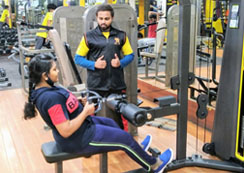
Common Training Principles/Systems
|
HOW MANY REPS AND HOW MUCH REST BETWEEN SETS? If your clients goal is Strength & Power: 4-6 reps- rest 3-4 minutes between sets. For people who want to increase their endurance, do 20-25 reps. This rep range is great for people who are overweight (ENDOMORPHS), higher than 20% body fat. You should rest only 1 minute between each set. This pace will help you drop body fat and increase your endurance and energy level. For people who want to increase their strength and endurance, as well as tone up, do 12-15 reps. These are the people who want to be firm without being bulky. Rest 2 minutes between sets. For people who are preparing for a contest or who want to keep their size and strength, but wish to drop body fat ("get cut"). Add a set of 20-25 reps for each body part. If this isn’t enough add one set per exercise. HOW MANY SETS SHOULD I PERFORM? Large muscles (quads, hams, lats, chest, abs) are capable of 6-9 sets without overtraining. Advanced bodybuilders should perform 1-3 sets per exercise and 1-3 exercises per muscle group. Small muscles (calves, shoulders, biceps, triceps, traps, forearms) are capable of no more than 6 sets without overtraining). Three sets per exercise is a good rule of thumb. REPETITIONS AND MUSCLES FIBERS If you work one set at 4-6 reps, one set at 12-15 reps, and one set at 20-25 reps, you get complete work of all muscle components: Red, White, and Pink Fibers. WHICH MUSCLES SHOULD I WORK FIRST? Work weak links and stabilizers first. Because the largest muscles require the most energy to work, you usually start with the largest muscles and work toward the smallest. For example, you would probably work your quadriceps before your calves. CONFUSE YOUR MUSCLES TO PROMOTE GROWTH Change your routine and order of exercises, reps, weight & rest schedules. Your muscles will adapt to any set routine or schedule. Exercises that work the muscles at different angles stimulate the muscle differently and ensure that every motor unit fires. For example, you could substitute incline dumbbell curls for straight bar bicep curls. FOR HARD GAINERS For hard gainers,(ECTOMORPHS), people who have a hard time gaining muscle mass or strength, do 3 sets of 6 reps max weight. Rest a minimum of 3 minutes between each set. INJURY WARNING: Doing one set to failure per muscle group or using negatives or forced reps are not recommended for any except the most advanced lifters due to the potential for injury. Beginners will not have the experienced technique or knowledge to be able to cope effectively Safety is always the first concern of a fitness instructor VARIATIONS IN TRAINING PLANS Drop Sets Double Drop Sets Descending Sets Giant Sets Super Sets Forced Reps Rest Pause COMMON TRAINING ROUTINES One Day Split: Work upper body, then take one day off, work lower Two Day Split: Work 2 consecutive days, then take one day off. Work upper body on day One, work lower body on day Two. Then take day three off. Repeat. Push-Pull Routine: Work 2 consecutive days, then take one day off (or you could just work out every other day). On day one you work the “pushing” muscles (triceps, chest, shoulders) then on day two you work the “pulling” muscles (biceps, back). Take day three off. Intermediate Antagonistic muscle group workout. Upper body/ lower body split. CircuitШ····¢ : Pushing- Pulling- Pressing: Works cardiovascular system as well as muscular system. It involves large muscle groups and increases fat burning potential. Keep reps high (20-25) and do not rest between exercises. Your objective is to complete all exercises in your circuit within a certain time limit. Expanded Circuit: A slightly more advanced version of Circuit training. Works smaller muscle groups more intensely. DON’T WORK THE SAME MUSCLE TWO DAYS IN A ROW The basic philosophy behind these routines is to work related muscles (muscles that synergistically assist one another during a lift) on the same day to ensure that they are given enough recovery time between workouts. For example, you wouldn’t want to bench press (which works the pectorals AND triceps) on Monday and then do tricep push downs on Tuesday-your triceps need a day off to grow stronger! Always advise clients on the importance of rest days. If they want to see proper development they have to give their muscles time to rest and grow. If a client is in every day do not be afraid to go and advise them. It is then up to them how they wish you train but you have done your best as an instructor. Remember, training, while hard work, should be fun. Ensure you convey that attitude to your clients. |

